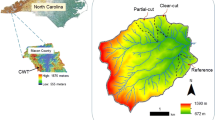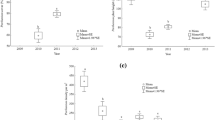Abstract
Declines in biodiversity can be caused by intense land-use or by land abandonment. Traditional plant-gathering in Japan has declined or has often been abandoned in recent decades. However, little is known about how traditional plant-gathering affects the diversity, productivity, and composition of plant communities. Traditionally, bracken (Pteridium aquilinum subsp. japonicum) served as a natural resource in Japan, and people continue to harvest it in some places. We conducted a 4-year field experiment in a cool-temperate grassland on the Sugadaira Plateau, Nagano Prefecture, comparing a continuous harvesting treatment of the dominant Pteridium with a non-harvested control. We wanted to determine whether Pteridium harvesting would alter plant species richness, total productivity, and plant community composition. Local people harvested Pteridium shoots in a 1800 m2 treatment area each year from 2011 to 2014. By 2014, species richness and diversity (Shannon index) had significantly increased while Pteridium abundance (number of shoots and biomass) had decreased in the harvest treatment when compared with the control. Total productivity, measured as combined aboveground biomass of all vascular plant species, was similar between the treatment and control; however, community composition differed. Harvested plots had a higher biomass of erect-formed, invasive and native species, but lower biomass of small-formed species when compared with the control. Our results suggest that traditional plant-gathering, such as periodic Pteridium harvesting can result in increases in plant diversity while total productivity is maintained. However, long-term monitoring is recommended to detect any subsequent undesirable changes in the community, such as increases in invasive species populations.


Similar content being viewed by others
References
Abul-Fatih HA, Bazzaz FA (1979) The biology of Ambrosia trifida L. I. Influence of species removal on the organization of the plant community. New Phytol 83:813–816
Bates D, Maechler M, Bolker B, Walker S (2014) lme4: Linear mixed-effects models using Eigen and S4. R package version 1.1-7. http://CRAN.R-project.org/package=lme4
Di Giulio M, Edwards PJ, Meister E (2001) Enhancing insect diversity in agricultural grasslands: the roles of management and landscape structure. J Appl Ecol 38:310–319
Díaz S, Symstad AJ, Stuart Chapin F, Wardle DA, Huenneke LF (2003) Functional diversity revealed by removal experiments. Trends Ecol Evol 18:140–146
Ghorbani J, Le Duc MG, McAllister HA, Pakeman RJ, Marrs RH (2006) Effects of the litter layer of Pteridium aquilinum on seed banks under experimental restoration. Appl Veg Sci 9:127–136
Grabherr G (1982) The impact of trampling by tourists on a high altitudinal grassland in the Tyrolean Alps, Austria. Vegetatio 48:209–217
Ikeda H, Okutomi K (1995) Effects of trampling and competition on plant growth and shoot morphology of Plantago, Eragrostis and Eleusine species. Acta Bot Neerl 44:151–160
Klanderud K (2005) Climate change effects on species interactions in an alpine plant community. J Ecol 93:127–137
Kleijn D, Kohler F, Báldi A, Batáry P, Concepción ED, Clough Y, Díaz M, Gabriel D, Holzschuh A, Knop E, Kovács A, Marshall EJP, Tscharntke T, Verhulst J (2009) On the relationship between farmland biodiversity and land-use intensity in Europe. Proc R Soc B 276:903–909
Kleijn D, Rundlöf M, Scheper J, Smith HG, Tscharntke T (2011) Does conservation on farmland contribute to halting the biodiversity decline? Trends Ecol Evol 26:474–481
Kobayashi T, Hori Y, Nomoto N (1997) Effects of trampling and vegetation removal on species diversity and micro-environment under different shade conditions. J Veg Sci 8:873–880
Kunte K (2008) Competition and species diversity: removal of dominant species increases diversity in Costa Rican butterfly communities. Oikos 117:69–76
Le Duc MG, Pakeman RJ, Marrs RH (2000) Vegetation development on upland and marginal land treated with herbicide, for bracken (Pteridium aquilinum) control, in Great Britain. J Envir Manage 58:147–160
Legendre P, Legendre L (1998) Numerical Ecology, 2nd edn. Elsevier, London
Marrs RH, Watt AS (2006) Biological flora of the British Isles: Pteridium aquilinum (L.) Kuhn. J Ecol 94:1272–1321
Marrs RH, Johnson SW, Le Duc MG (1998a) Control of bracken and restoration of heathland. VI. The response of bracken to 18 years of continued bracken control or 6 years of control followed by recovery. J Appl Ecol 35:479–490
Marrs RH, Johnson SW, Le Duc MG (1998b) Control of bracken and restoration of heathland. VII. The response of bracken rhizomes to 18 years of continued bracken control or 6 years of control followed by recovery. J Appl Ecol 35:748–757
Marrs RH, Johnson SW, Le Duc MG (1998c) Control of bracken and restoration of heathland. VIII. The regeneration of the heathland community after 18 years of continued bracken control or 6 years of control followed by recovery. J Appl Ecol 35:857–870
Marrs RH, Le Duc MG, Mitchell RJ, Goddard D, Paterson S, Pakeman RJ (2000) The ecology of bracken: its role in succession and implications for control. Ann Bot 85:3–15
Ministry of the Environment, Government of Japan (2012) The National Biodiversity Strategy of Japan 2012–2020 (in Japanese)
Morimoto Y (2011) What is Satoyama? Point for discussion on its future direction. Landscape Ecol Eng 7:163–171
Munson SM, Lauenroth WK (2009) Plant population and community responses to removal of dominant species in the shortgrass steppe. J Veg Sci 20:224–232
Oksanen J, Blanchet FG, Kindt R, Legendre P, Minchin PR, O’Hara RB, Simpson GL, Solymos P, Stevens MHH, Wagner H (2015) Vegan: Community Ecology Package. R package version 2.2-1. http://CRAN.R-project.org/package=vegan
Osawa T, Kohyama K, Mitsuhashi H (2013) Areas of increasing agricultural abandonment overlap the distribution of previously common, currently threatened plant species. PLoS One 8:e79978
Pakeman RJ, Marrs RH (1992) The conservation value of bracken Pteridium aquilinum (L.) Kuhn-dominated communities in the UK, and an assessment of the ecological impact of bracken expansion or its removal. Biol Conserv 62:101–114
Pimm S (1984) The complexity and stability of ecosystems. Nature 307:321–326
R Core Team (2014) R: A language and environment for statistical computing. R Foundation for Statistical Computing, Vienna. ISBN:3-900051-07-0. http://www.R-project.org
Roth A-M, Campbell D, Keddy P, Dozier H, Montz G (2008) How important is competition in a species-rich grassland? A two-year removal experiment in a pine savanna. Ecoscience 15:94–100
Sasaki T, Lauenroth WK (2011) Dominant species, rather than diversity, regulates temporal stability of plant communities. Oecologia 166:761–768
Sasaki T, Ohsawa M (2005) Community structure and species diversity under trampling around a mountain trail, in semi-natural grassland, Mt. Higashi Otafuku, Hyogo, Central Japan. J Japanese Soc Grassland Sci 51:251–256 (In Japanese with English synopsis)
Shimada Y (1962) Ecology of bracken (Pteridium aquilinum (L.) KUHN): dynamics of bracken population in native grassland: dynamics of bracken population in native grassland. J Weed Sci Tech 1:70–77 (in Japanese)
Shimada Y (1966) Ecological studies on the improvement of native grassland by herbicide: I. dynamics of communities by spreading of sodium salt of 2,3,6-trichlorobenzoic acid (TCBA) in Miscanthus-Pteridium type grassland. J Weed Sci Tech 5:123–131 (In Japanese)
Stewart G, Cox E, Le Duc M, Pakeman R, Pullin A, Marrs R (2008) Control of Pteridium aquilinum: meta-analysis of a multi-site study in the UK. Ann Bot 101:957–970
Sun D, Liddle MJ (1993) Plant morphological characteristics and resistance to simulated trampling. Envir Manage 17:511–521
Symstad AJ, Tilman D (2001) Diversity loss, recruitment limitation, and ecosystem functioning: lessons learned from a removal experiment. Oikos 92:424–435
Takeuchi K (2010) Rebuilding the relationship between people and nature: the Satoyama Initiative. Ecol Res 25:891–897
Tilman D, Downing J (1994) Biodiversity and stability in grasslands. Nature 367:363–365
Tilman D, Reich PB, Knops J, Wedin D, Mielke T, Lehman C (2001) Diversity and productivity in a long-term grassland experiment. Science 294:843–845
Tilman D, Reich PB, Knops JMH (2006) Biodiversity and ecosystem stability in a decade-long grassland experiment. Nature 441:629–632
Uchida K, Ushimaru A (2014) Biodiversity declines due to abandonment and intensification of agricultural lands: patterns and mechanisms. Ecol Monogr 84:637–658
Vassilev K, Pedashenko H, Nikolov SC, Apostolova I, Dengler J (2011) Effect of land abandonment on the vegetation of upland semi-natural grasslands in the Western Balkan Mts, Bulgaria. Plant Biosyst 145:654–665
Yamaura Y, Royle A, Shimada N, Asanuma S, Sato T, Taki H, Makino S (2012) Biodiversity of man-made open habitats in an underused country: a class of multispecies abundance models for count data. Biodivers Conserv 21:1365–1380
Acknowledgments
We wish to thank Ms. Mariko Katsuyama and Mr. Kouji Nagaoka for their research assistance, Dr. Yousuke Degawa for the field management related to forcible entry, Dr. Leanne Kay Faulks for correcting English of this manuscript, and to members of the Sugadaira Montane Research Center for valuable advice on the field research. This study was partially supported by Research and Education Funding for the Japanese Alps Inter-Universities Cooperative Project, of the Ministry of Education, Culture, Sports, Science and Technology, Japan.
Author information
Authors and Affiliations
Corresponding author
Electronic supplementary material
Below is the link to the electronic supplementary material.
About this article
Cite this article
Suzuki, R.O., Kenta, T., Sato, M. et al. Continuous harvesting of a dominant bracken alters a cool-temperate montane grassland community and increases plant diversity in Nagano, Japan. Ecol Res 31, 639–644 (2016). https://doi.org/10.1007/s11284-016-1372-9
Received:
Accepted:
Published:
Issue Date:
DOI: https://doi.org/10.1007/s11284-016-1372-9




